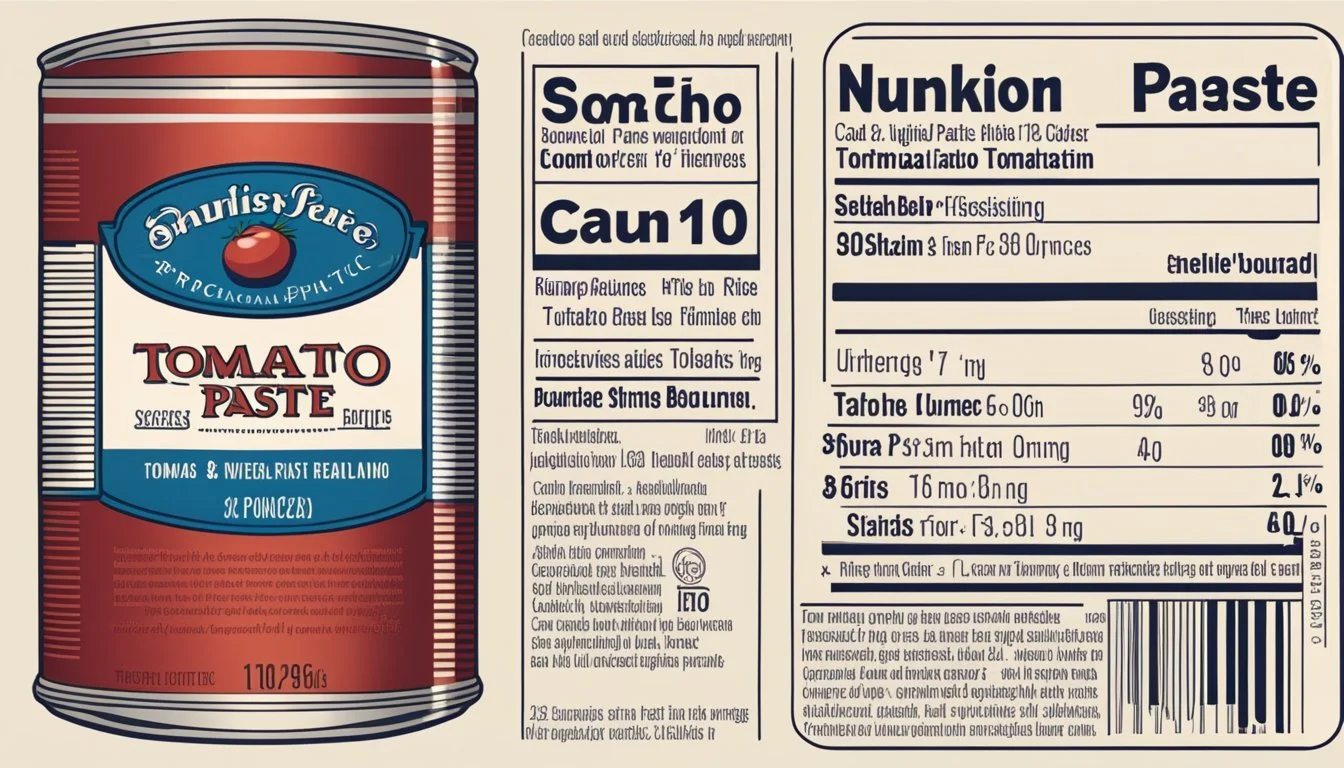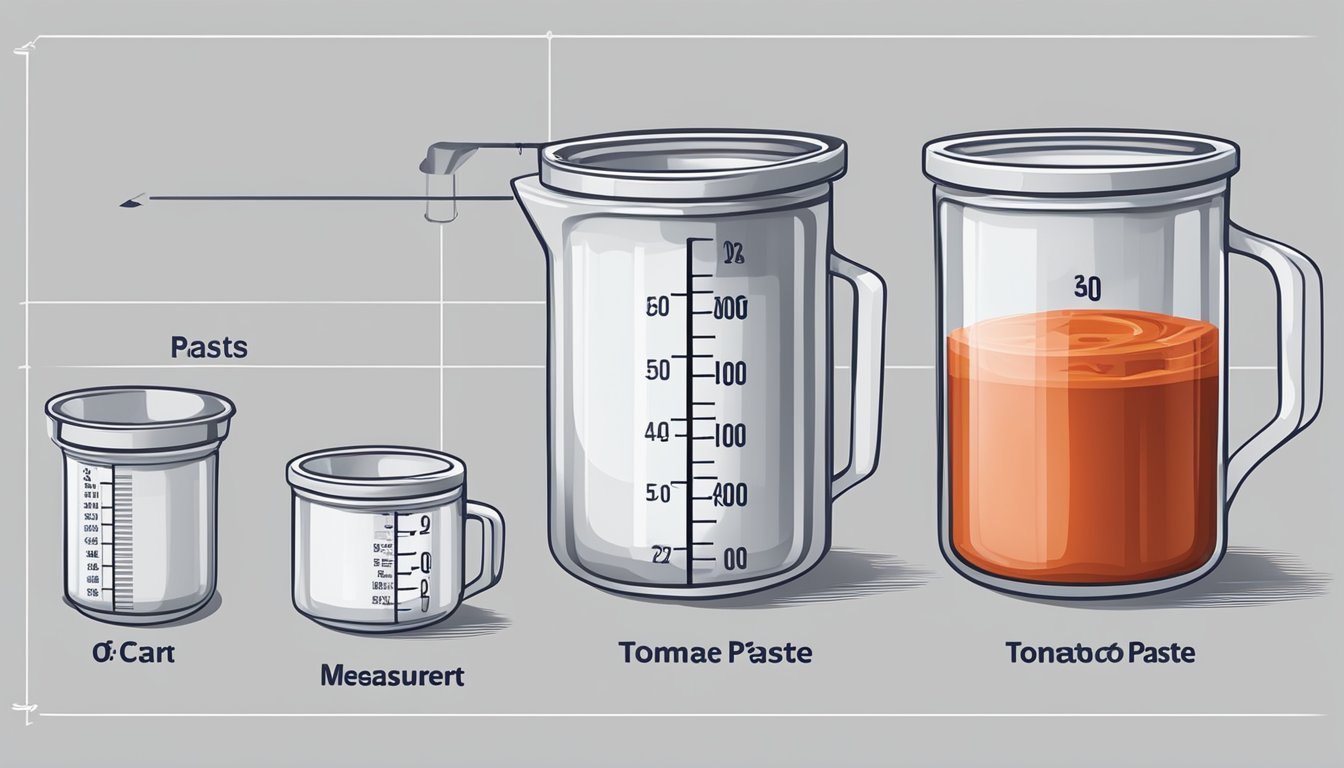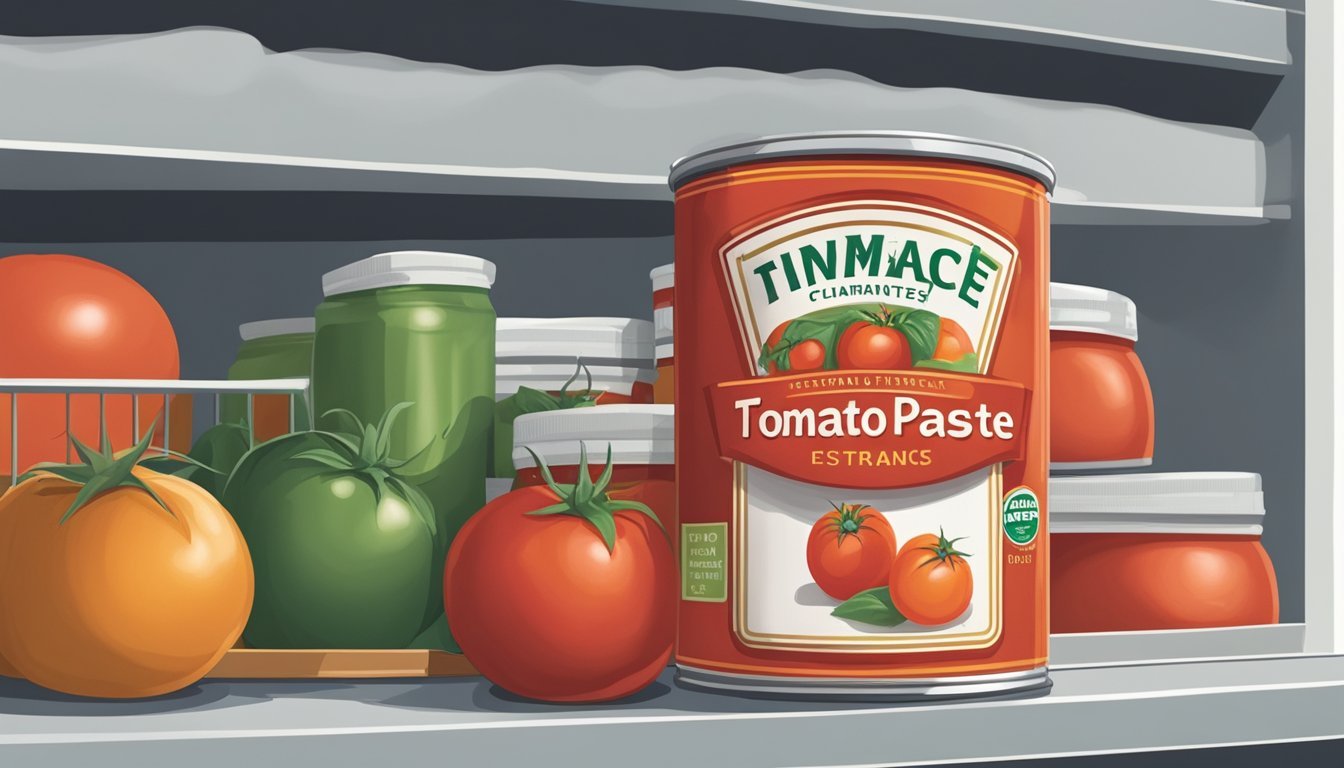How Many Ounces in a Can of Tomato Paste?
Know Your Measurements
Tomato paste is a concentrated form of tomatoes that have been cooked down, strained to remove skins and seeds, and further cooked until it has reached a thick, rich consistency. This pantry staple is commonly used to add depth of flavor and richness to a variety of dishes, including sauces, soups, and stews. Canned tomato paste is particularly useful for its convenience and shelf stability, offering a ready-to-use ingredient that heightens the tomato taste in culinary creations.
Commonly, tomato paste comes in small cans, which are measured by weight in ounces rather than by volume. The size of the can affects the amount of tomato paste it contains. A standard small can of tomato paste holds 6 ounces. This size is ideal for most recipes because it allows for precise measurement without waste. Understanding the weight-to-volume conversion is crucial for those who need to scale recipes or substitute fresh tomatoes with canned tomato paste for their consistent flavor and texture.
Canned tomato paste's standardization in ounces enables cooks and chefs to plan recipes accurately. When interpreting recipes or adjusting quantities, one might encounter varying demands for the amount of tomato paste, based on the specific needs of the dish being prepared. Knowing that the typical can of tomato paste contains 6 ounces aids in these adjustments and ensures that dishes achieve the desired taste and consistency.
Understanding Tomato Paste
Tomato paste is a concentrated form of tomatoes, known for its deep flavor and thick consistency. It is a staple ingredient in many cuisines, utilized for its rich color and ability to add body to dishes.
Types of Tomato Paste
Tomato paste can generally be found in two forms: canned and tube. Each form presents its unique advantages in terms of storage and usage flexibility. Canned tomato paste is commonly sold in 6-ounce cans, while tube tomato paste often comes in 4.5-ounce sizes. The tube format is praised for its convenience and ability to keep the paste fresher for longer once opened.
Canned Tomato Paste Packaging
Cans provide a cost-effective way to package tomato paste. The label on these cans typically includes information on the net weight, which usually ranges from 6 ounces to larger sizes for bulk usage. The label may also list ingredients such as citric acid, which is added to preserve color and flavor.
Tomato Paste Ingredients
The primary ingredient in tomato paste is tomatoes that have been cooked down to remove water content. The end product is a concentrated form of tomato, often with added citric acid as a preservative. The paste does not typically contain any significant additives or seasonings, allowing it to retain the pure taste of tomato.
Culinary Uses of Tomato Paste
Tomato paste is a concentrated ingredient widely utilized in cooking to bring depth and richness to dishes. From a robust base for sauces and soups to a flavor enhancer in various recipes, its thick consistency and intense tomato flavor make it a staple in kitchens worldwide.
Enhancing Flavors in Recipes
In many recipes, chefs use tomato paste as a foundational flavor enhancer. During cooking, adding it early on allows the paste to caramelize, giving a noticeable depth to the dish. Tomato paste can be stirred into sautés or sofritos, where it melds with onions, garlic, and other aromatics to create an umami-rich base.
Creating Base for Sauces and Soups
Tomato paste serves as an excellent thickener for sauces and soups, contributing a desirable consistency and robust tomato flavor. It is often used in the initial stages of cooking, where it's incorporated with a little water or broth, ensuring the flavors disperse evenly throughout the sauce or soup.
Sauces: Bolognese, marinara, and pizza sauce benefit from tomato paste for both taste and texture.
Soups: A tablespoon can deepen the flavor profile of minestrone or a tomato-based chowder.
Using Tomato Paste in Stews and Casseroles
Stews and casseroles (What wine goes well with casseroles?) often rely on tomato paste to enrich the taste and provide a hearty thickness. As part of the initial stages, cooks brown the paste with the ingredients before liquids like broth or wine are added. This method builds a complex taste foundation.
Stews: Whether it’s a vegetable stew or one containing meats like beef or lamb, a dollop of tomato paste can amplify the overall flavor.
Casseroles: Adding tomato paste to layers in a bean or vegetable casserole will introduce a subtle tang and increase the savory notes.
Measuring and Converting Tomato Paste
In cooking, it is crucial to measure ingredients accurately. Specificity in the amount of tomato paste can greatly affect the texture and flavor of a dish.
Common Can Sizes and Ounces
Tomato paste typically comes in small cans, and the size can impact recipes.
Picnic: ranges from 10 1/2 to 12 ounces and holds approximately 1 1/4 cups.
Common Size: a 6-ounce can translates to about 3/4 cup.
Tablespoons to Ounces Conversion
Understanding the conversion between tablespoons and fluid ounces is vital for measuring tomato paste in recipes.
Conversion: 1 fluid ounce is equivalent to 2 tablespoons.
In Practice: A 6-ounce can of tomato paste would, therefore, contain 12 tablespoons.
Adjusting Recipes
One may need to adjust recipes when substituting between different forms of tomato paste, like tubed or canned, due to differences in concentration and volume.
Concentration: Tube tomato paste is often double-concentrated. When substituting, use half the amount the recipe calls for in canned paste.
Volume to Weight: An adjustment is sometimes needed between volume (cups or tablespoons) and weight (ounces), considering that the thickness of tomato paste affects its weight compared to its volume.
Storage and Preservation
Proper storage methods for tomato paste are essential to maintain its quality and extend its shelf life. These techniques involve refrigeration, freezing, and the use of airtight containers, tailored specifically for leftover tomato paste.
Refrigerating Leftover Tomato Paste
When storing leftover tomato paste in the refrigerator, consistency in temperature is key. One should aim to keep it at a temperature range of 35-40°F (1.6-4.4°C). To refrigerate:
Transfer the tomato paste to an airtight container; exposure to air can spoil the paste.
A consistent temperature helps preserve the paste for about 5-7 days while maintaining quality and flavor.
Freezing for Extended Shelf Life
For those looking to preserve tomato paste for an extended period, freezing is an excellent option. To freeze tomato paste:
Use a tablespoon to portion out dollops onto a lined tray (use freezer or wax paper).
Freeze the dollops until they are solid.
Once frozen, transfer the dollops into a freezer-safe container or bag to prevent freezer burn.
This method can extend the shelf life significantly, allowing the tomato paste to be used as needed in future cooking endeavors.
Using Airtight Containers
Whether one is refrigerating or freezing leftover tomato paste, an airtight container is vital. It prevents air from entering and causing spoilage and also helps in keeping the paste fresh whether it's being stored in the fridge or the freezer. To utilize airtight containers:
Select small storage containers designed for freezer or refrigerator use.
Ensure a snug fit of the lid to create an impermeable barrier to air.
Clearly label the container with the freezing or refrigeration date for future reference.
By using these containers, one can help to preserve the integrity of the tomato paste for future culinary use.
Substitutes and Alternatives
When a recipe calls for tomato paste and it's unavailable, cooks can rely on a range of homemade and store-bought substitutes. Understanding the consistency and flavor differences will ensure these alternatives provide the desired outcome in dishes.
Homemade Tomato Paste
To create homemade tomato paste, cooks can simmer down tomato sauce, crushed tomatoes, or even puree diced or fresh tomatoes. The goal is to evaporate excess water and achieve the thick, concentrated consistency of tomato paste. One should start with at least double the tomato product and reduce it to match the amount of paste needed.
Store-Bought Alternatives
Store-bought substitutes include options like double-concentrated tube tomato paste, canned tomatoes that can be reduced, or products like ketchup, which can be used in a 1:1 ratio due to its similar consistency. When selecting an alternative, it's important to account for variances in flavor and additional ingredients present in the product.
Other Tomato Products as Substitutes
Several other tomato products may serve as substitutes:
Canned tomatoes: These can be pureed and reduced to mimic the paste's texture.
Diced tomatoes: When blended and simmered, they can replace tomato paste; just note they are less concentrated.
Tomato sauce: A convenient alternative, but one must reduce it considerably to approach the consistency of tomato paste.
Crushed tomatoes: With a thicker base than sauce, they require less reduction to form a paste-like substitute.
Puree: Similar to paste but thinner; reduction is necessary.
Fresh tomatoes: Peeling, deseeding, and reducing fresh tomatoes will yield a lighter, fresher-tasting paste substitute.
Each option brings a unique flavor and texture profile that can complement the intended recipe when used thoughtfully.
Nutritional and Health Considerations
When considering the nutritional and health aspects of tomato paste, it is crucial to pay attention to its sodium content and the variety of nutrients it provides, including calcium.
Sodium and Preservatives
Tomato paste is relatively low in calories and can be a healthful addition to meals. However, it typically contains sodium, which is used as a preservative to extend its shelf life. A single 6-ounce can of tomato paste contains around 1% of the Daily Value (DV) for sodium. Consumers should be mindful of their sodium intake as high levels can contribute to health issues such as high blood pressure.
Calcium and Other Nutritional Values
In addition to sodium, tomato paste offers a range of nutritional benefits. It is a good source of calcium, which is important for bone health, with each 6-ounce can providing approximately 1% of the Daily Value for calcium. Tomato paste also provides vitamins and minerals, including:
Potassium: Vital for heart function and blood pressure regulation.
Vitamin C: Important for immune system support and skin health.
Vitamin E: An antioxidant that helps protect cells from damage.
Here is a summary of the nutritional content in a 6-ounce can of tomato paste:
Nutrient Amount per 6 oz can % Daily Value Calories 139 - Total Fat 0.8g 1% Saturated Fat 0.2g 1% Sodium varies ~1% Calcium varies ~1%
Consumers are encouraged to check labels for specific nutrient amounts as values can vary between brands and products.
Cooking Tips and Tricks
When using tomato paste, its rich flavor and thick consistency can significantly elevate a dish's quality. The key is knowing how to integrate its unique properties effectively.
Enhancing Dishes with Tomato Paste
Tomato paste, with its concentrated tomato flavor, is a staple in cooking that adds a deep layer of umami to recipes. To utilize its full potential, chefs often stir in tomato paste early during the cooking process, allowing it to caramelize and meld with ingredients like garlic and olive oil. This caramelization unlocks a richer taste in sauces and stews.
Balancing Acid and Sweetness
Tomato paste is naturally acidic, but it can also bring a touch of sweetness to a dish when cooked properly. To balance the flavors, chefs may add a pinch of sugar or salt, which enhances the tomato paste's inherent sweetness while taming its acidity. This technique is particularly effective in tomato-based sauces, (What wine goes well with tomato-based sauces?) ensuring a harmonious flavor profile.
Improving Texture and Thickness
Tomato paste excels at adding both texture and thickness to dishes, contributing to a more robust and smooth mouthfeel. Its thick consistency is ideal for thickening soups and sauces without changing the original taste significantly. A spoonful of tomato paste blended well into the preparation can transform a watery sauce into a richly textured one, providing an enhanced sensory experience.How Many Ounces in a Can of Tomato Paste? Know Your Measurements
Tomato paste is a concentrated form of tomatoes that have been cooked down, strained to remove skins and seeds, and further cooked until it has reached a thick, rich consistency. This pantry staple is commonly used to add depth of flavor and richness to a variety of dishes, including sauces, soups, and stews. Canned tomato paste is particularly useful for its convenience and shelf stability, offering a ready-to-use ingredient that heightens the tomato taste in culinary creations.








